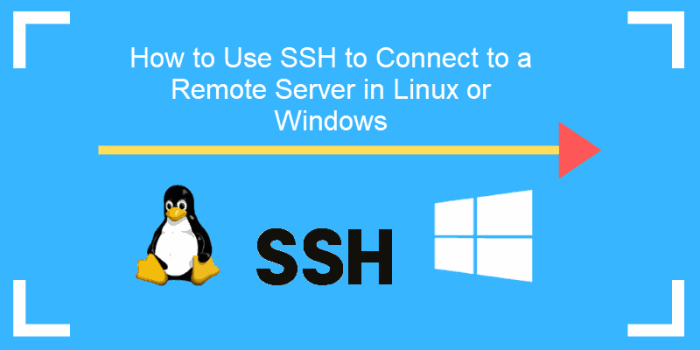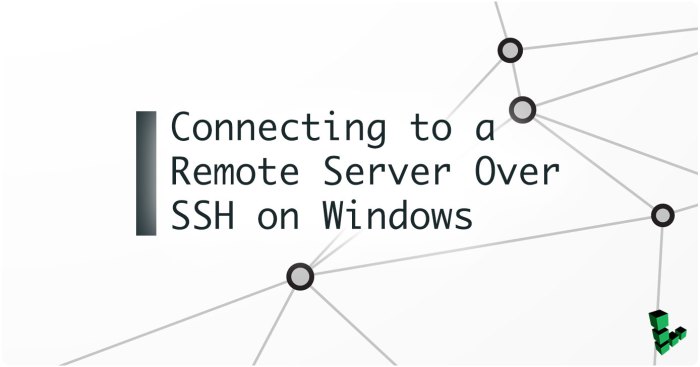In the realm of remote server management, SSH (Secure Shell) plays a pivotal role, enabling secure and efficient access to systems across networks. However, when a user encounters difficulties establishing an SSH connection, a methodical troubleshooting approach is crucial to identify and resolve the underlying issue.
This comprehensive guide will delve into the potential causes and solutions for SSH connectivity problems, empowering users to diagnose and overcome these challenges effectively.
Network Connectivity Verification
Establishing a secure connection to a remote server via SSH requires a stable network connection. This section guides you through the process of verifying network connectivity and ensuring a clear path between your local machine and the remote server.
Network connectivity can be verified using various network utilities, such as ping and traceroute. Ping sends ICMP echo requests to the remote server and measures the round-trip time (RTT) and packet loss. Traceroute, on the other hand, provides a detailed view of the network path, including the hops and latency at each hop.
Ping Test
- Open a terminal or command prompt on your local machine.
- Type the following command, replacing “example.com” with the IP address or domain name of the remote server:
ping example.com
- The output of the ping command will display the RTT and packet loss percentage. A successful ping response indicates that the remote server is reachable and responsive.
Traceroute Test
- Open a terminal or command prompt on your local machine.
- Type the following command, replacing “example.com” with the IP address or domain name of the remote server:
traceroute example.com
- The output of the traceroute command will display the hops along the network path, the latency at each hop, and any packet loss.This information can help identify potential network issues or bottlenecks.
SSH Configuration Validation
To ensure a successful SSH connection, it’s crucial to verify the configuration settings on both the client and server. This involves checking that the SSH port is accessible, the user has the necessary credentials, and the SSH configuration is correct.
Let’s delve into each aspect in detail:
SSH Port Accessibility
- Confirm that the SSH port (typically port 22) is open and accessible on the server.
- Use tools like
netstat
or
ss
to check if the port is listening.
- If the port is closed, configure the firewall or security settings to allow incoming SSH connections.
User Credentials
- Ensure that the user attempting to connect has a valid SSH key or password.
- Check if the user is authorized to connect to the server by examining the server’s SSH configuration files.
- If necessary, create a new SSH key or reset the user’s password to grant access.
SSH Configuration
- Review the SSH configuration files (typically
/etc/ssh/sshd_config
on the server and
~/.ssh/config
on the client) to ensure they are configured correctly.
- Check settings like the SSH protocol version, encryption algorithms, and authentication methods.
- Make any necessary adjustments to the configuration files to optimize security and compatibility.
Firewall and Security Group Rules
Firewall rules and security group settings can prevent SSH connections. To troubleshoot, check if the user’s IP address is allowed to connect to the server and if any firewall rules or security group settings are blocking the connection.
Review the firewall rules and security group settings to ensure they allow the SSH connection. If necessary, adjust the rules or settings to permit the connection.
User IP Address Permission
- Verify that the user’s IP address is allowed to connect to the server.
- Check the firewall rules and security group settings to ensure they allow connections from the user’s IP address.
Firewall Rule Adjustment
- If the firewall is blocking the connection, adjust the firewall rules to allow SSH traffic.
- Ensure the firewall rules are configured to allow incoming connections on port 22 (the default SSH port).
Security Group Rule Adjustment
- If security groups are being used, adjust the security group rules to allow SSH traffic.
- Ensure the security group rules are configured to allow incoming connections on port 22 from the user’s IP address.
Authentication Issues
Establishing a successful SSH connection relies heavily on proper authentication. To ensure seamless access, it’s crucial to verify the following aspects:
Credentials Verification
- Confirm that the user attempting the connection is using the correct username and password or SSH key.
- Check if two-factor authentication is enabled for the user’s account and complete the necessary steps for authentication.
- If necessary, reset the user’s password or SSH key to eliminate any potential issues with the credentials.
SSH Server Status
To verify the SSH server’s operation, we must confirm it is active and receptive on the designated port. Additionally, we should examine the server logs for any anomalies or alerts pertaining to SSH connections. If necessary, restarting the SSH server may resolve the issue.
Checking Server Status
Determine if the SSH server is running and listening on the expected port. Utilize the following command:
netstat
-an | grep sshd
The output should display a line indicating the SSH server is listening on the expected port, typically port 22.
Checking Server Logs
Inspect the server logs for any error messages or warnings related to SSH connections. Common log files to check include:
/var/log/auth.log/var/log/secure/var/log/messages
Search for entries containing “sshd” or “SSH” to identify any relevant issues.
Restarting SSH Server
If the SSH server is not running or encountering issues, restarting it may resolve the problem. Execute the following command:
sudo systemctl restart sshd
After restarting the SSH server, attempt to connect again to verify if the issue is resolved.
Port Forwarding

Port forwarding plays a significant role in enabling secure connections to remote SSH servers. It allows specific ports on the local machine to be forwarded to the corresponding ports on the remote server.
To ensure a successful connection, it’s crucial to verify the port forwarding configuration and ensure it’s active. If port forwarding is not required, it should be disabled to prevent potential security vulnerabilities.
- Check if port forwarding is being used in the SSH connection.
- Verify the accuracy of the port forwarding configuration, including the source and destination ports.
- Confirm that the port forwarding is active and functioning properly.
- Disable port forwarding if it’s not necessary for the connection.
DNS Resolution

DNS resolution plays a crucial role in connecting to a remote SSH server. It ensures that the hostname of the server is translated into the correct IP address, enabling the SSH client to establish a connection.
To verify DNS resolution, follow these steps:
DNS Server Verification
- Check if the DNS server configured on your local machine is resolving the hostname of the remote SSH server correctly.
- Use the ‘nslookup’ command to query the DNS server for the hostname and verify the IP address it returns.
Hostname Resolution
- Ensure that the hostname you are using to connect to the SSH server is correct and resolves to the expected IP address.
- If the hostname does not resolve to the correct IP address, check if there are any typos or errors in the hostname.
DNS Cache and Alternative DNS
- If you suspect that the DNS cache may be causing issues, try clearing the cache or using a different DNS server.
- You can use commands like ‘sudo dscacheutil
-flushcache’ on macOS or ‘ipconfig /flushdns’ on Windows to clear the DNS cache. - If using a different DNS server, update the DNS settings on your local machine and try connecting to the SSH server again.
VPN or Proxy Connections

If the connection to the remote SSH server is still not established, determine if the user is connecting through a VPN or proxy server. Check if the VPN or proxy settings are configured properly. If the VPN or proxy connection is not required, disable it.
Client Software Compatibility
Ensure compatibility between the SSH client software on the user’s computer and the SSH server.
Outdated or incompatible SSH client software can cause connection issues. To resolve this, update the SSH client to the latest version or consider using a different SSH client if compatibility issues persist.
Update SSH Client Software
- Check for software updates for the SSH client.
- Install the latest updates to ensure compatibility.
Use a Different SSH Client
- If updating the SSH client does not resolve the issue, try using a different SSH client.
- Consider using a well-known and supported SSH client like OpenSSH.
Advanced Troubleshooting
Advanced troubleshooting involves more in-depth analysis and may require specialized tools or assistance from network administrators.
Capture and Analyze SSH Connection Logs
SSH connection logs record events and errors during the connection process. Capturing and analyzing these logs can help identify specific issues, such as authentication failures, network errors, or configuration problems.
Use Network Sniffing Tools
Network sniffing tools allow you to monitor the SSH connection in real-time. This can help detect any potential problems, such as dropped packets, protocol violations, or malicious activity.
Contact the Network Administrator or Hosting Provider
If the issue persists after trying the above steps, it may be necessary to contact the network administrator or hosting provider. They may have access to additional tools and resources to assist with advanced troubleshooting.
Outcome Summary
By systematically addressing each aspect of the SSH connection process, from network connectivity to authentication and server configuration, this troubleshooting guide provides a structured approach to resolving SSH connectivity issues. By following the steps Artikeld in this guide, users can quickly restore their SSH connections and resume their remote server management tasks.